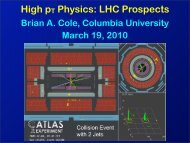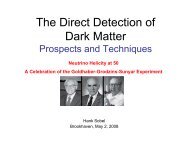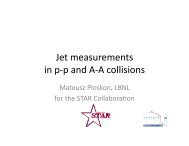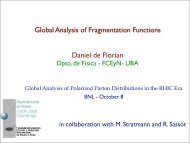One flavor QCD Abstract - BNL theory groups - Brookhaven National ...
One flavor QCD Abstract - BNL theory groups - Brookhaven National ...
One flavor QCD Abstract - BNL theory groups - Brookhaven National ...
You also want an ePaper? Increase the reach of your titles
YUMPU automatically turns print PDFs into web optimized ePapers that Google loves.
m(a)<br />
g(a)<br />
CP<br />
FIG. 6: As the cutoff is removed, the bare coupling and mass flow towards zero. Different flow lines<br />
correspond to different renormalized quark masses. With sufficiently negative mass one enters the regime<br />
of spontaneous CP violation. Anomaly effects preclude the line of vanishing bare quark mass from being<br />
renormalization group invariant.<br />
The quantities Λ qcd and M are integration constants for the renormalization group equations.<br />
We refer to Λ qcd as the overall strong interaction scale and M as the renormalized quark mass.<br />
Their values depend on the explicit renormalization scheme as well as the physical values being<br />
held fixed in the renormalization process, i.e. the proton and η ′ masses. This connection is highly<br />
non-perturbative. Indeed the particle masses being fixed are long distance properties, and thus are<br />
tied to the renormalization group flow far out of the perturbative regime.<br />
Turning things around, we can consider the physical particle masses as functions of these integration<br />
constants. Simple dimensional analysis tells us that the dependence of physical masses<br />
must take the form<br />
m p = Λ qcd H p (M/Λ qcd ) (51)<br />
m η ′ = Λ qcd H η ′(M/Λ qcd ) (52)<br />
where the H i (x) are dimensionless functions whose detailed form is highly non-perturbative.<br />
For the case of multiple degenerate quark <strong>flavor</strong>s we expect the square of the lightest boson<br />
mass to vanish linearly as the renormalized quark mass goes to zero. This means we anticipate<br />
a square root singularity in the corresponding H(x) at x = 0. Indeed, requiring the singularity to<br />
occur at the origin removes any additive non-perturbative ambiguity in defining the renormalized<br />
20






